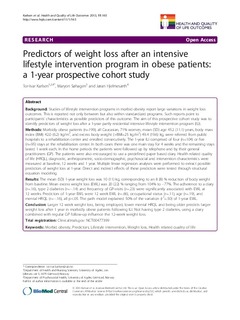| dc.contributor.author | Karlsen, Tor-Ivar | |
| dc.contributor.author | Søhagen, Maryon | |
| dc.contributor.author | Hjelmesæth, Jøran | |
| dc.date.accessioned | 2014-01-10T11:57:10Z | |
| dc.date.available | 2014-01-10T11:57:10Z | |
| dc.date.issued | 2013 | |
| dc.identifier.citation | Karlsen, T.-I., Søhagen, M., & Hjelmesæth, J. (2013). Predictors of weight loss after an intensive lifestyle intervention program in obese patients: a 1-year prospective cohort study. Health and Quality of Life Outcomes, 11(1), 1-9. doi: 10.1186/1477-7525-11-165 | no_NO |
| dc.identifier.issn | 1477-7525 | |
| dc.identifier.uri | http://hdl.handle.net/11250/138731 | |
| dc.description | Published Version of an article in the journal: Health and Quality of Life Outcomes. Also available from the publisher at: http://dx.doi.org/10.1186/1477-7525-11-165 Open access | no_NO |
| dc.description.abstract | Background
Studies of lifestyle intervention programs in morbid obesity report large variations in weight loss outcomes. This is reported not only between but also within standardized programs. Such reports point to participants’ characteristics as possible predictors of this outcome. The aim of this prospective cohort study was to identify predictors of weight loss after a 1-year partly residential intensive lifestyle intervention program (ILI).
Methods
Morbidly obese patients (n=199), all Caucasian, 71% women, mean (SD) age 45.2 (11.1) years, body mass index (BMI) 42.0 (6.2) kg/m2, and excess body weight (>BMI=25 kg/m2) 49.4 (19.6) kg, were referred from public hospitals to a rehabilitation center and enrolled consecutively. The 1-year ILI comprised of four (n=104) or five (n=95) stays at the rehabilitation center. In both cases there was one main stay for 4 weeks and the remaining stays lasted 1 week each. In the home periods the patients were followed up by telephone and by their general practitioners (GP). The patients were also encouraged to use a predefined paper based diary. Health related quality of life (HRQL), diagnostic, anthropometric, socio-demographic, psychosocial and intervention characteristics were measured at baseline, 12 weeks and 1 year. Multiple linear regression analyses were performed to extract possible predictors of weight loss at 1-year. Direct and indirect effects of these predictors were tested through structural equation modeling.
Results
The mean (SD) 1-year weight loss was 10 (11) kg, corresponding to an 8 (8) % reduction of body weight from baseline. Mean excess weight loss (EWL) was 20 (22) % ranging from 104% to -77%. The adherence to a diary (r=.16), type 2 diabetes (r=-.14) and frequency of GP-visits (r=.23) were significantly associated with EWL at 12 weeks. Predictors of 1-year EWL were 12 week EWL (r=.66), occupational status (r=.11), age (r=.19), and mental HRQL (r=-.16), all p<.05. The path model explained 50% of the variation (r2=.50) of 1-year EWL.
Conclusion
Larger 12 week weight loss, being employed, lower mental HRQL and being older predicts larger weight loss after 1 year in morbidly obese patients following ILI. Not having type 2 diabetes, using a diary combined with regular GP follow-up influence the 12-week weight loss. | no_NO |
| dc.language.iso | eng | no_NO |
| dc.publisher | BioMed Central | no_NO |
| dc.subject | morbid obesity | no_NO |
| dc.subject | predictors | no_NO |
| dc.subject | lifestyle intervention | no_NO |
| dc.subject | weight loss | no_NO |
| dc.subject | health related quality of life | no_NO |
| dc.title | Predictors of weight loss after an intensive lifestyle intervention program in obese patients: a 1-year prospective cohort study | no_NO |
| dc.type | Journal article | no_NO |
| dc.type | Peer reviewed | no_NO |
| dc.subject.nsi | VDP::Medical disciplines: 700::Health sciences: 800 | no_NO |
| dc.source.pagenumber | 1-9 | no_NO |
| dc.source.volume | 11 | no_NO |
| dc.source.journal | Health and Quality of Life Outcomes | no_NO |
| dc.source.issue | 1 | no_NO |
| dc.identifier.doi | 10.1186/1477-7525-11-165 | |
